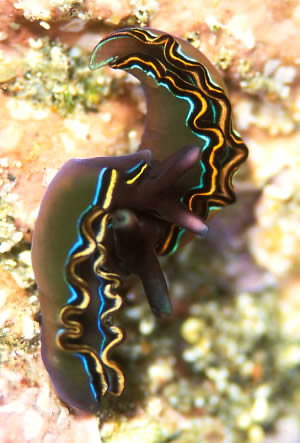
Thuridilla livida
(Baba, 1955)
Order: SACOGLOSSA
Superfamily: ELYSIOIDEA
Family: Elysiidae
DISTRIBUTION
Enewetak, Marshall Islands, Okinawa, Japan, Guam, Aldabra Atoll, South Africa. [Also Great Barrier Reef, Australia - see record ]
PHOTO
Hachijo Island, Japan, May 18, 2002 Photo: Shouichi Kato
Living animals are dark brown to black. The head and rhinophores are black. The tips of the rhinophores have an opaque white pigment. The parapodia are lined with a series of longitudinal lines of orange, black and blue. These lines are also present along the anterior margin of the foot.
T. livida is most closely related to T. hoffae Gosliner, 1995. The main difference between T. livida and T. hoffae is the narrow iridescent blue submarginal line present on T. livida. Alternatively, T. hoffae has a series of submarginal blue to blue green patches. T. livida has orange and blue lines of the anterior margin of the foot that are absent in T. hoffae. The general body colour is darker in T. hoffae than in T. livida.
References:
• Baba, K. (1955) Opisthobranchia of Sagami Bay, Supplement. Iwanami Shoten, Tokyo. 59pp.
• Gosliner, T.M. (1995) The genus Thuridilla (Opisthobranchia: Elysiidae) from the tropical Indo-Pacific, with a revision of their phylogeny and systematics of the Elysiidae. Proceedings of the California Academy of Sciences, 49(1): 1-54.
Rudman, W.B., 2001 (June 12) Thuridilla livida (Baba, 1955). [In] Sea Slug Forum. Australian Museum, Sydney. Available from http://www.seaslugforum.net/find/thurlivi
Related messages
Thuridilla hoffae? found sthn Queensland
September 5, 2007
From: Gary Cobb
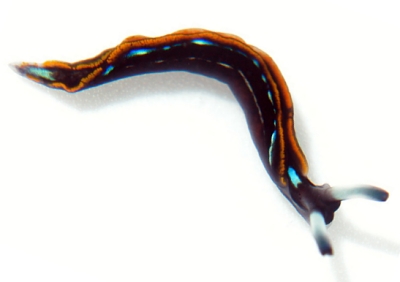
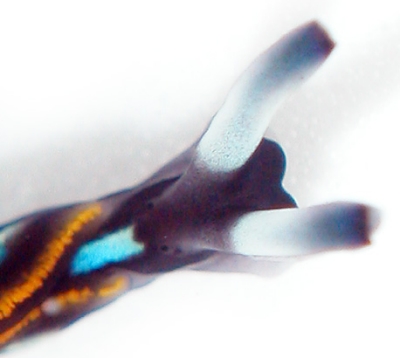
Hi Bill and everyone!
Well yet again the Sunshine Coast continues to reveal more species. Here is the 317th species found here! Thuridlla hoffae which appears to be another new record for sthn Queensland. Note the 'light blue band running parallel to the paradodial edge' is a series of broken blotches of brilliant blue.
It's nice for the 'Gentleman Scientists' to find yet another Thuridilla here.
Locality: Mooloolaba Sunshine Coast, 20 m, Queensland, Australia, Pacific Ocean, 01 September 2007, Subtidal. Length: 14 mm. Photographer: Gary Cobb.
Cheers
Gary Cobb
gary@nudibranch.com.au
Cobb, G.C., 2007 (Sep 5) Thuridilla hoffae? found sthn Queensland. [Message in] Sea Slug Forum. Australian Museum, Sydney. Available from http://www.seaslugforum.net/find/20631
Dear Gary,
I suspect this is T. livida rather then T. hoffae. When I used 'band' on the Fact Sheet to describe the blue on the parapodia I was trying to differentiate between the bright blue line found in T. livida and the more diffuse light or pale blue broad band seen in the photo on the T. hoffae Fact Sheet. In fact the original description describes the blue as 'blue-green blotches covering most of the parapodia' much like in Marina Poddubetskaia's animals [#11525].
Your animals are also a bit unusual in having a thin orange line midway down the parapodia, and the bright blue patch behind the rhinophores, but as I said in a comment on one of your other messages, it is early days in understanding colour variability in these new species of Thuridilla so every new photo is valuable, even if we can't be totally sure of their identity.
Best wishes,
Bill Rudman
Thuridilla livida from SE Sulawesi
November 24, 2005
From: Linda Ianniello
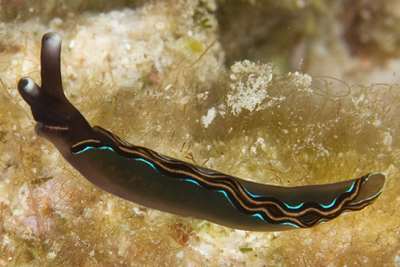
Dr. Bill,
I believe this is a Thuridilla livida from SE Sulawesi. I see that you don't have very many images of this species.
Locality: Outer Pinnacle dive site, Hoga Island, SE Sulawesi. Indonesia, November 5, 2005. Coral wall. Photographer: Linda Ianniello
Regards,
Linda I.
lindai1@bellsouth.net
Ianniello, L., 2005 (Nov 24) Thuridilla livida from SE Sulawesi. [Message in] Sea Slug Forum. Australian Museum, Sydney. Available from http://www.seaslugforum.net/find/15347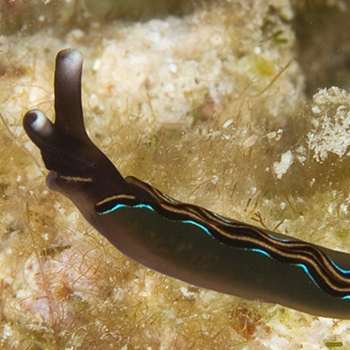
Dear Linda,
Thanks for another record. As I often say the more photos we get, the better idea we have of variation in a species. Your photo is interesting because it shows the blue pigmentation arrange in a series of elongate patches, rather than a continuous, supporting Skip Pierce's earlier comments about the 'mobility' of some elysiid pigments. It;s alos clear from your photo that the background colour of the animal rather than being described as dark brown or black is better described as translucent grey with a distinct greenish tinge from the internal digestive gland.
Best wishes,
Bill Rudman
Thuridilla livida from the northern Marianas
November 15, 2005
From: Takao Urasawa
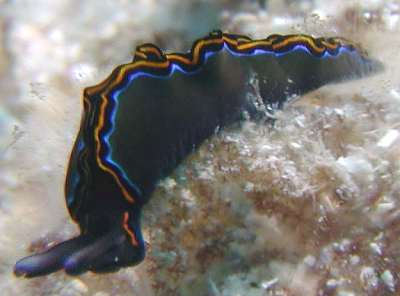
Dear Dr Rudman
Is this Thuridilla hoffae?
Locality: Wing beach, Saipan, Northern Mariana Islands. Depth: 12 m. Length: 20 mm. on the coral. Photographer: Takao Urasawa
Takao Urasawa
dswith@isletwind.com
Takao Urasawa, 2005 (Nov 15) Thuridilla livida from the northern Marianas. [Message in] Sea Slug Forum. Australian Museum, Sydney. Available from http://www.seaslugforum.net/find/15201Dear Takao,
This is Thuridilla livida. Both this species and T. hoffae are reported from the Mariana Ids, but T. livida has a more colour bands at the mantle edge. Gosliner (1995) describes the parapodia to be bordered with a series of lines - "The innermost line is black followed by lines of orange, black and bright blue..." I can only assume he means the outermost not innermost line is black, as in your photo the order of the lines is reversed..
Best wishes,
Bill Rudman
Thuridilla livida from Indonesia?
May 4, 2005
From: Roberto Sozzani
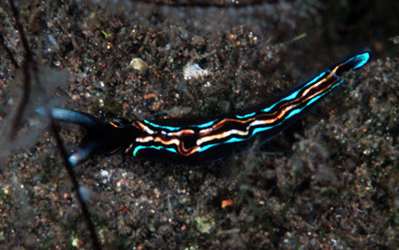
Dear Bill,
I think this is a Thuridilla livida. The blue band seems larger than in the other photos. Sorry for the poor quality, but I couldn't get close enough.
Locality: Sangeang island, Indonesia. Depth: 22 metres. Length: 15 mm. June 2003. Sandy slope. Photographer: Roberto Sozzani
Best regards
Roberto Sozzani
www.robertosozzani.it
roberto.sozzani@fastwebnet.it
Sozzani, R., 2005 (May 4) Thuridilla livida from Indonesia?. [Message in] Sea Slug Forum. Australian Museum, Sydney. Available from http://www.seaslugforum.net/find/13677Dear Roberto,
It certainly looks like it but hopefully Terry Gosliner can confirm it for us
Best wishes,
Bill Rudman
New record of Thuridilla livida from the GBR
February 2, 2005
From: Ingo Burghardt
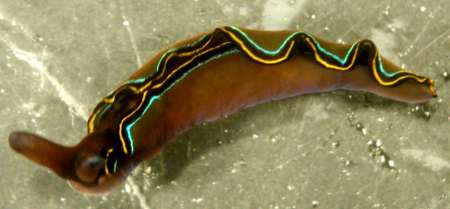
Dear Bill,
Happy New Year 2005 and thank you for opening the Forum again! Congratulation! :-)
I've noticed that that there was no record of Thuridilla livida from the Great Barrier Reef. Here it is: I've found one specimen of Thuridilla livida in the shallow waters of Bird Island. As far as I can tell there was no photosynthetic activity measurable (by Diving-PAM), so either this species is not able to retain living chloroplasts or it just keeps them photosynthetic active for a short period of time...
Locality: Bird Island (Lizard Is. Group, Great Barrier Reef). Australia, Coral Sea. Depth: 1-2 m. Length: 14 mm. 18 August 2004. Intertidal, between coral rubble. Photographer: Ingo Burghardt
Cheers,
Ingo
ingo.burghardt@rub.de
Burghardt, I., 2005 (Feb 2) New record of Thuridilla livida from the GBR. [Message in] Sea Slug Forum. Australian Museum, Sydney. Available from http://www.seaslugforum.net/find/12907Thanks Ingo,
It's nice to get a record from this part of the IWP.
Best wishes,
Bill Rudman
Lindsay Warren's Elysia sp. 1
June 6, 2002
From: Clay Carlson
Bill,
Just looking at Lindsay Warren's Elysia sp. 1. The colored stripes on the head would suggest T. livida. We have pale forms with brownish-purple sides and pale rhinophores; not white though.
Clay
ccarlson@kuentos.guam.net
Carlson, C., 2002 (Jun 6) Lindsay Warren's Elysia sp. 1. [Message in] Sea Slug Forum. Australian Museum, Sydney. Available from http://www.seaslugforum.net/find/7157Thanks Clay,
I see I said that it was 'definitely' a species of Elysia. Actually Shouichi Kato's photo in which the black background pigment is very translucent, is a good intermediate step between Lindsay's description and more 'typical' specimens.
Thanks for clearing up another unknown
Cheers,
Bill Rudman
Re: Thuridilla from Hachijo Island, Japan
May 18, 2002
From: Shouichi Kato

Dear Bill,
Thank you for your reply about my Thuridilla.
I'm very interested in it and I tried to find the animal intermediate in colour between that light colored animal (A) and 'typical' T. livida (B). Unfortunately I haven't found it yet, but type B can be seen commonly during begining of Spring and Summer at shallow reef. I attached the picture of type B, usually very small, max 15mm in size. But type A was quite larger than type B, around 25mm in size.
And more, it can't be seen clearly in my picture, type A doesn't have orange line but their background is wholly orange.
I wonder if type A and type B are different species.
Thanks and best regards,
S. Kato
regulus@edit.ne.jp
Kato, S., 2002 (May 18) Re: Thuridilla from Hachijo Island, Japan. [Message in] Sea Slug Forum. Australian Museum, Sydney. Available from http://www.seaslugforum.net/find/6958Dear Shouichi,
Thanks for these photos of typical Thuridilla livida. I am sure you are right in thinking that your light coloured animal is a different species. What I was suggesting is that it is always worth having a look to see how much colour variation you can find. Sometimes we do find a species that is so variable in colour that we can be mistaken into thinking that different variants are different species.
Best wishes,
Bill Rudman
Thuridilla livida from the Seychelles
June 15, 2001
From: Erwin Köhler
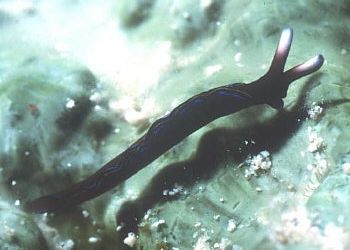
Dear Bill,
This one was made by Frank Gloystein (Frank.Gloystein@t-online.de) at the Seychelles, Bird Island on March 19, 2001, length about 2 cm, depth about 12 m.
Erwin
Erwin@medslugs.de
Köhler, E., 2001 (Jun 15) Thuridilla livida from the Seychelles. [Message in] Sea Slug Forum. Australian Museum, Sydney. Available from http://www.seaslugforum.net/find/4564Thanks Erwin,
Bill Rudman
Thuridilla livida with egg mass
June 15, 2001
From: Lindsay Warren
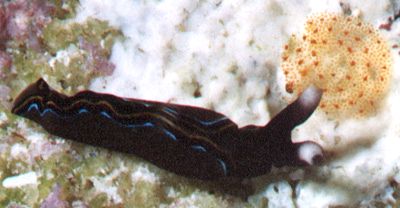
Dear Bill
Thought you might be interested in this shot of a Thuridilla livida which laid this egg mass while in one of our temporary holding dishes. It was found by Guillermo Moreno on 17 September 1999 at 4pm at a depth of 4 m on Pulau Hoga, Tukang Besi Archipelago, S.E. Sulawesi (Operation Wallacea). Size: 7 mm. Photo: Lindsay Warren.
All the best
Lindsay
alldcl@compuserve.com
Warren, L. , 2001 (Jun 15) Thuridilla livida with egg mass. [Message in] Sea Slug Forum. Australian Museum, Sydney. Available from http://www.seaslugforum.net/find/4571Thanks Lindsay,
A very useful addition to the Forum and the identifiable egg mass is indeed a bonus
Best wishes,
Bill Rudman
Elysia from Sulawesi
April 6, 1999
From: Lindsay Warren
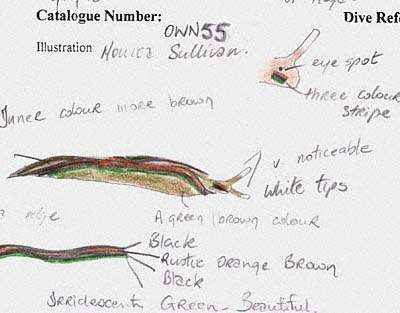
Dear Bill
Please find attached a rough illustration of a possible Elysia found in the Tukang Besi Islands, SE Sulawesi last year during the research for
quite similar to Elysia livida but with a green/brown body with orange, iridescent green (definitely not blue) and black lines. The head had the same colour markings in stripes beneath the eye. The rhinophores fade halfway ending in white. The parapodia edges were tipped with black followed by a band of rustic orange brown, then black and finally irridescent green. It was found at a depth of 1.8 m on the underside of rubble and was possibly feeding on very fine green algae growing on the rubble.
All the best
Lindsay
100014.2112@compuserve.com
Warren, L., 1999 (Apr 6) Elysia from Sulawesi. [Message in] Sea Slug Forum. Australian Museum, Sydney. Available from http://www.seaslugforum.net/find/744Dear Lindsay,
Its definitely a species of Elysia but I am not too confident about a species name for it.
Best wishes,
Bill Rudman.
